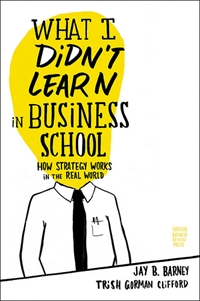Recommended Resource – What I Didn’t Learn in Business School
What I Didn’t Learn in Business School: How Strategy Works in the Real World
by Jay B. Barney and Trish Gorman Clifford
About the Reference
What I Didn’t Learn in Business School: How Strategy Works in the Real World by Jay Barney and Trish Gorman Clifford reveals the shortfalls of the principles learned in the idealistic academic environment when applied directly to the messy, unpredictable and politically charged business world. Through a storied approach, Jay and Trish reveal the inadequacies of modeling to fully predict business outcomes and the challenge of creating alignment among leaders with differing points of view and personal agendas. They go on to illustrate the power of moving leaders past the limits of these barriers and their own collective experience to gain significant marketplace advantages and organizational prosperity.
Benefits of Using this Reference
StrategyDriven Contributors like What I Didn’t Learn in Business School because it so clearly illustrates the premise for our website, namely, that while highly beneficial, academic principles must be adapted from the ideal environment of the classroom to the unpredictable environment of the shop floor in order to provide real value to any organization. Furthermore, no single model or performance measure can adequately portray a given situation in such a way that a definitive decision can be made. Rather, multiple models and measures should be employed to create a complete picture of performance from differing perspectives to enable robust decision-making.
Its well supported, fully illustrated assertion that strong business performance is achieved through the application of sound academic principles tempered by real-world business experience makes What I Didn’t Learn in Business School a StrategyDriven recommended read.


 Michael Feuer co-founded OfficeMax in 1988 starting with one store and $20,000 of his own money, a partner, and a small group of investors. As CEO, he grew it to more than 1,000 stores worldwide with annual sales topping $5 billion. He is also CEO of Max-Ventures, a venture capital and retail consulting firm, and founder and CEO of Max-Wellness, a comprehensive health and wellness retail chain that launched in 2010. After opening initial laboratory test stores in Florida and Ohio, a national roll-out is now underway. To read Michael Feuer’s complete biography,
Michael Feuer co-founded OfficeMax in 1988 starting with one store and $20,000 of his own money, a partner, and a small group of investors. As CEO, he grew it to more than 1,000 stores worldwide with annual sales topping $5 billion. He is also CEO of Max-Ventures, a venture capital and retail consulting firm, and founder and CEO of Max-Wellness, a comprehensive health and wellness retail chain that launched in 2010. After opening initial laboratory test stores in Florida and Ohio, a national roll-out is now underway. To read Michael Feuer’s complete biography,  Hank Moore has advised 5,000+ client organizations worldwide (including 100 of the Fortune 500, public sector agencies, small businesses and non-profit organizations). He has advised two U.S. Presidents and spoke at five Economic Summits. He guides companies through growth strategies, visioning, strategic planning, executive leadership development, Futurism and Big Picture issues which profoundly affect the business climate. He conducts company evaluations, creates the big ideas and anchors the enterprise to its next tier. The Business Tree™ is his trademarked approach to growing, strengthening and evolving business, while mastering change. To read Hank’s complete biography,
Hank Moore has advised 5,000+ client organizations worldwide (including 100 of the Fortune 500, public sector agencies, small businesses and non-profit organizations). He has advised two U.S. Presidents and spoke at five Economic Summits. He guides companies through growth strategies, visioning, strategic planning, executive leadership development, Futurism and Big Picture issues which profoundly affect the business climate. He conducts company evaluations, creates the big ideas and anchors the enterprise to its next tier. The Business Tree™ is his trademarked approach to growing, strengthening and evolving business, while mastering change. To read Hank’s complete biography,